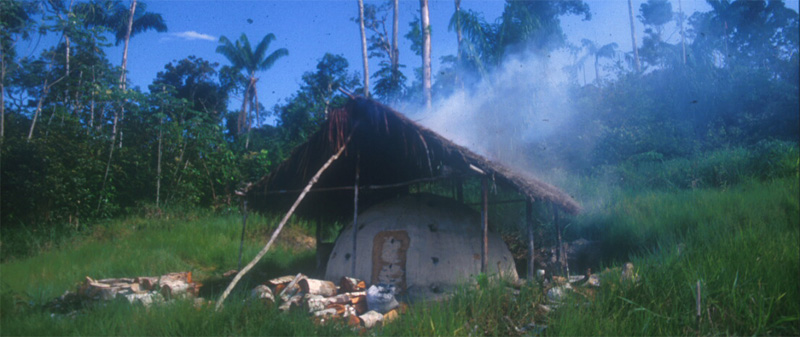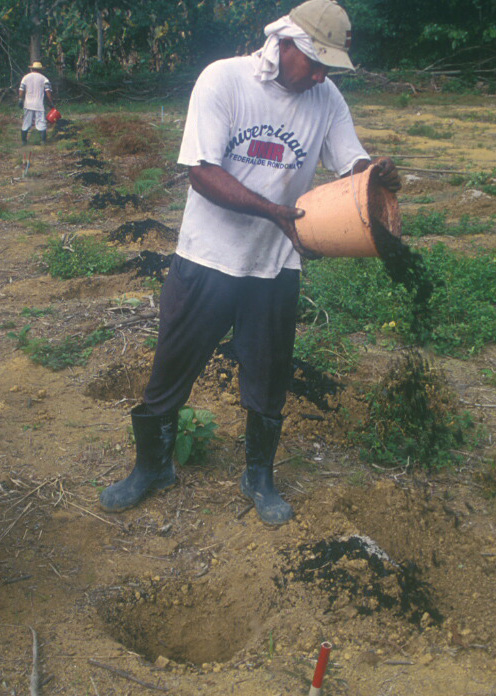|
Page 1 of 5 Soil Charcoal Amendments (agrichar or biochar) maintain Soil Fertility and establish a Carbon Sink
The existence of an anthropogenic and carbon (C) enriched dark soil in different parts of the world and especially in Amazonia (Amazonian Dark Earths (ADE) or Terra Preta de Índio) proves that the predominant Ferralsols and Acrisols can be transformed into fertile soils. Charcoal formation and deposition in soils seems to be a promising option to transfer an easily decomposable biomass into refractory soil organic matter (SOM) pools. The production of charcoal for soil amelioration purposes (slash and char) out of the aboveground biomass (secondary forest and crop residues) instead of converting it to carbon dioxide (CO2) through burning (slash and burn) could establish a C sink and could be an important step towards sustainability and SOM conservation in tropical agriculture.

On a global scale, crop residue biomass represents a considerable problem as well as new challenges and opportunities. Bio-char soil management systems can deliver tradable C emissions reduction, and C sequestered is easily accountable, and verifiable. The described mixture of driving forces and technologies has the potential to use residual waste carbon-rich residues to reshape agriculture, balance carbon and address nutrient depletion.
 Tropical forests account for between 20 and 25% of the world terrestrial carbon (C). Soils under tropical forest contain approximately the same amount of C as the lush vegetation above it. The current conversion of Amazonian forest to agricultural land makes disturbance of this C stock important to the global C balance and net greenhouse gas emissions. Changes in land use, particularly by clearing forests, reduce organic C by 20% to 50% in the upper soil layers. Furthermore, this reduction of soil organic matter (SOM) is causing soil degradation. Thus agriculture is not sustainable without nutrient inputs beyond 3 years of cultivation. The efficiency of conventional fertilizers (such as nitrogen (N)) is limited by a low nutrient retention capacity conjoined with strong tropical rains. On the other hand, large amounts of phosphate fertilizers are needed to overcome the soil’s high P-fixation capacity. Tropical forests account for between 20 and 25% of the world terrestrial carbon (C). Soils under tropical forest contain approximately the same amount of C as the lush vegetation above it. The current conversion of Amazonian forest to agricultural land makes disturbance of this C stock important to the global C balance and net greenhouse gas emissions. Changes in land use, particularly by clearing forests, reduce organic C by 20% to 50% in the upper soil layers. Furthermore, this reduction of soil organic matter (SOM) is causing soil degradation. Thus agriculture is not sustainable without nutrient inputs beyond 3 years of cultivation. The efficiency of conventional fertilizers (such as nitrogen (N)) is limited by a low nutrient retention capacity conjoined with strong tropical rains. On the other hand, large amounts of phosphate fertilizers are needed to overcome the soil’s high P-fixation capacity.
|




 Tropical forests account for between 20 and 25% of the world terrestrial carbon (C). Soils under tropical forest contain approximately the same amount of C as the lush vegetation above it. The current conversion of Amazonian forest to agricultural land makes disturbance of this C stock important to the global C balance and net greenhouse gas emissions. Changes in land use, particularly by clearing forests, reduce organic C by 20% to 50% in the upper soil layers. Furthermore, this reduction of soil organic matter (SOM) is causing soil degradation. Thus agriculture is not sustainable without nutrient inputs beyond 3 years of cultivation. The efficiency of conventional fertilizers (such as nitrogen (N)) is limited by a low nutrient retention capacity conjoined with strong tropical rains. On the other hand, large amounts of phosphate fertilizers are needed to overcome the soil’s high P-fixation capacity.
Tropical forests account for between 20 and 25% of the world terrestrial carbon (C). Soils under tropical forest contain approximately the same amount of C as the lush vegetation above it. The current conversion of Amazonian forest to agricultural land makes disturbance of this C stock important to the global C balance and net greenhouse gas emissions. Changes in land use, particularly by clearing forests, reduce organic C by 20% to 50% in the upper soil layers. Furthermore, this reduction of soil organic matter (SOM) is causing soil degradation. Thus agriculture is not sustainable without nutrient inputs beyond 3 years of cultivation. The efficiency of conventional fertilizers (such as nitrogen (N)) is limited by a low nutrient retention capacity conjoined with strong tropical rains. On the other hand, large amounts of phosphate fertilizers are needed to overcome the soil’s high P-fixation capacity.